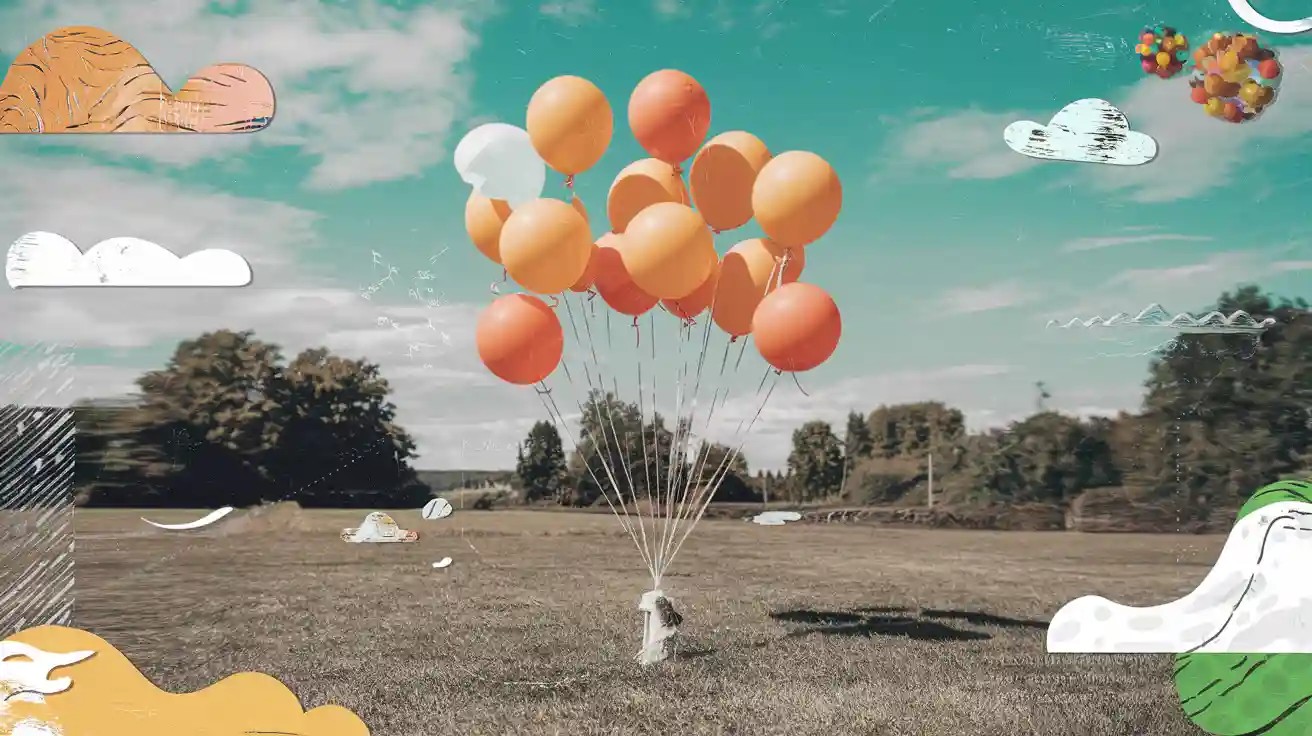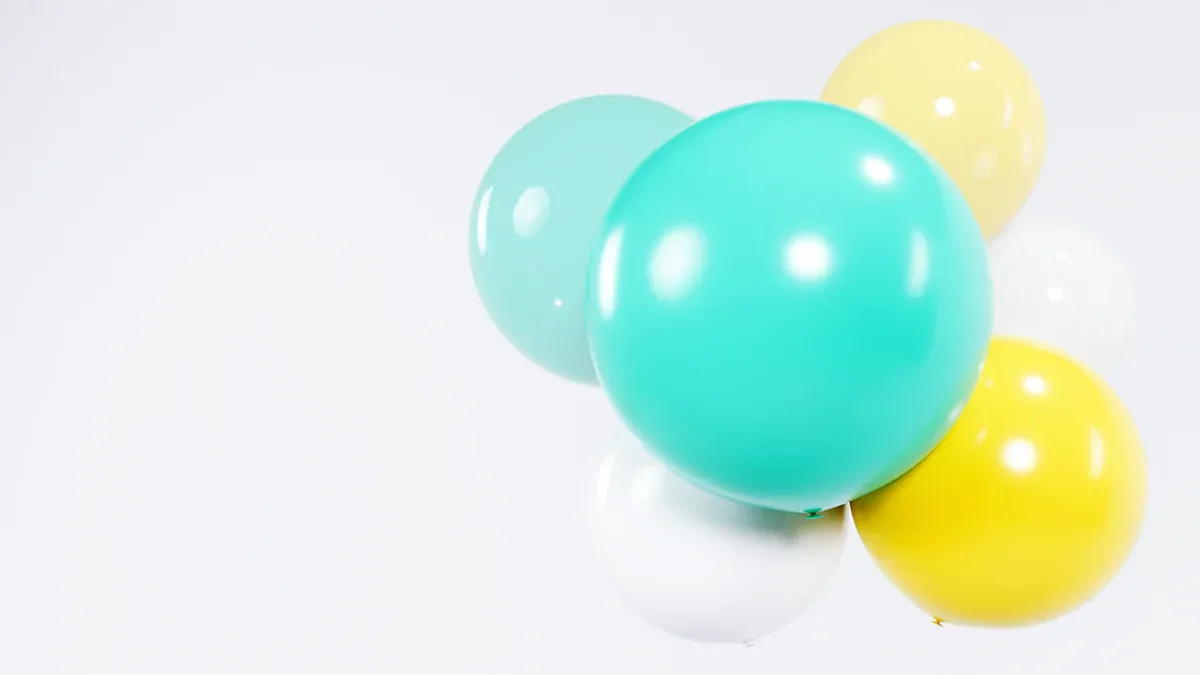
Helium balloons are great for outdoor events but don’t float long. Latex balloons with helium usually last 7 to 10 hours outside. Heat, sunlight, and humidity can make them deflate faster. Dark balloons get hotter, which makes them lose helium quickly. Cooler weather helps balloons stay up longer. How long they last depends on these conditions.
Key Takeaways
Helium-filled latex balloons last 7 to 10 hours outdoors. Heat, sunlight, and humidity can shorten this time.
Use Hi-Float gel to extend balloon float time significantly. This simple step can make balloons last for days.
Choose larger balloons for outdoor events. Bigger balloons hold more helium and float longer than smaller ones.
Factors That Affect How Long Helium Balloons Last Outdoors
Impact of Heat and Temperature
Heat affects how long helium balloons float. When it’s hot, helium expands and escapes faster through the balloon. This is why balloons deflate quicker on warm days. Did you know that every 100°F rise in temperature adds about 7 pounds of lift per 1,000 cubic feet of helium? While this might seem helpful, it actually makes helium escape faster. Latex balloons also weaken in extreme heat, causing them to deflate sooner. To make them last longer, keep balloons away from sunlight and heat.
Effects of Wind and Air Pressure
Wind can damage helium balloons. Strong winds may push them into sharp objects or stretch the latex, causing leaks or tears. Air pressure changes, especially at high altitudes, can also shorten their float time. If your event is in a windy area, secure your balloons to stop them from flying away or breaking.
UV Exposure and Sunlight Damage
Sunlight harms helium-filled latex balloons. UV rays break down the latex, making it weak and easy to pop. A study showed that after six hours in sunlight, 44 out of 50 balloons popped due to UV damage. Over time, sunlight causes balloons to crack, soften, or tear. Using shade or UV-resistant balloons can help protect them.
Role of Balloon Size and Material Quality
Balloon size and quality are important for float time. Bigger balloons hold more helium, so they float longer. High-quality latex balloons leak less helium than cheaper ones. Here’s a simple table showing what affects float time:
Factor |
What It Means |
|---|---|
Size |
Bigger balloons float longer |
Material |
Latex or foil impacts how long they last |
Hi-Float Treatment |
Helps balloons float much longer |
Temperature |
Indoors vs outdoors changes float time |
Shape |
Round balloons last longer than other shapes |
Sealing Quality |
Good seals keep helium inside better |
Picking the right size and material helps balloons last longer outside.
Practical Tips to Make Helium Balloons Last Longer
Add Hi-Float for Longer Float Time
Hi-Float helps balloons stay up longer. It’s a gel that coats the inside of latex balloons. This slows helium from escaping. Without Hi-Float, an 11-inch balloon floats for 18-24 hours. With Hi-Float, it can last for days! Apply the gel before inflating the balloon. This easy step is great for outdoor events.
Choose Bigger Latex Balloons
Large balloons hold more helium. More helium means they float longer. Bigger balloons also look cooler and last longer than small ones. For example, an 11-inch balloon floats for 18-24 hours. A 16-inch balloon floats even longer. Use bigger balloons for outdoor events to make them last.
Inflate Balloons Right Before the Event
Inflate balloons close to your event time. This keeps them fresh and floating. Balloons filled the night before may lose helium by morning. Freshly inflated balloons look better and last longer. This ensures your decorations stay nice during the event.
Keep Balloons Out of Direct Sunlight
Sunlight makes balloons deflate fast. Latex balloons last only 4-5 hours in the sun. Shade or shelter can help them last longer. Use tents, trees, or canopies to protect balloons. This simple trick keeps them floating longer on sunny days.
Don’t Overinflate Balloons
Overinflating balloons makes them pop or leak faster. Stretching them too much weakens the latex. Inflate balloons to the right size for longer life. Properly filled balloons are stronger and look better for your event.
Comparing Latex Balloons to Other Types of Helium Balloons

Latex Balloons vs. Foil Balloons
Choosing between latex and foil balloons shows clear differences. Latex balloons are cheap and biodegradable, making them great for short events. But they only float for 7 to 10 hours with helium. Foil balloons, also called Mylar balloons, last much longer—up to three weeks! This makes them ideal for multi-day events.
Foil balloons are stronger and less likely to pop. They hold helium longer than latex balloons. However, they cost more and are not eco-friendly. Here’s a simple comparison:
Balloon Type |
Float Time (Helium) |
Float Time (Air) |
Lifespan |
|---|---|---|---|
Mylar (Foil) |
Up to 3 weeks |
N/A |
Longer than latex |
Latex |
7 to 10 hours |
A few days to a week |
Shorter than mylar |
For outdoor events, foil balloons handle sunlight and wind better. They are less likely to pop or deflate quickly. If you need a cheaper option, latex balloons are still a good choice.
Latex Balloons vs. Bubble Balloons
Bubble balloons are another option besides latex balloons. These are made from clear, stretchy plastic, giving them a unique look. They are tougher than latex balloons and can last several days outside. Unlike latex, bubble balloons resist UV rays and heat, so they don’t fade or weaken in sunlight.
Latex balloons are stretchier and come in more colors and shapes. They’re great for fun, colorful decorations. But they pop more easily in windy or rainy weather. Some high-quality latex balloons have coatings to repel water and last longer, making them better for outdoor use.
Key points to think about:
Bubble balloons are great outdoors because they resist UV rays and punctures.
Treated latex balloons with Hi-Float gel can last for days.
Latex balloons offer more designs but are less durable in bad weather.
If you want something long-lasting and unique, bubble balloons are a great choice. For colorful and affordable decorations, latex balloons are still a favorite.
Helium latex balloons float 8-15 hours outside. Their lifespan depends on heat, wind, and sunlight. To help them last longer, use Ultra Hi-Float. Pick larger balloons and inflate them close to your event. For outdoor use, try foil or bubble balloons. These float over 15 hours and handle tough weather better.
Here’s a simple guide to make balloons last:
Method |
How It Helps |
|---|---|
Add Ultra Hi-Float gel |
Makes balloons float up to 3 times longer |
Use foil, mylar, or vinyl balloons |
Stay afloat for 2-5 days |
Pick bigger balloons |
Float for 2-5 days |
Use air-filled balloons (non-floating) |
Last weeks or months when displayed |
Keep away from sunlight and rain |
Stops faster deflation outdoors |
Test balloons in similar conditions before your event. This helps you plan better. With good prep, your helium balloons will look great and stay up during your celebration.
FAQ
How do you know if a helium balloon is overfilled?
An overfilled balloon looks stretched and feels very tight. It might also look like a pear instead of a circle. Inflate it slowly to prevent this.
Can helium balloons handle rain?
Rain makes latex balloons weaker. Water adds weight, causing them to deflate faster. Use a roof or waterproof balloons for rainy outdoor events.
How should you throw away latex helium balloons?
Pop the balloons and put them in the trash. Latex balloons break down over time but are not quick to decompose. Never release them into nature.








